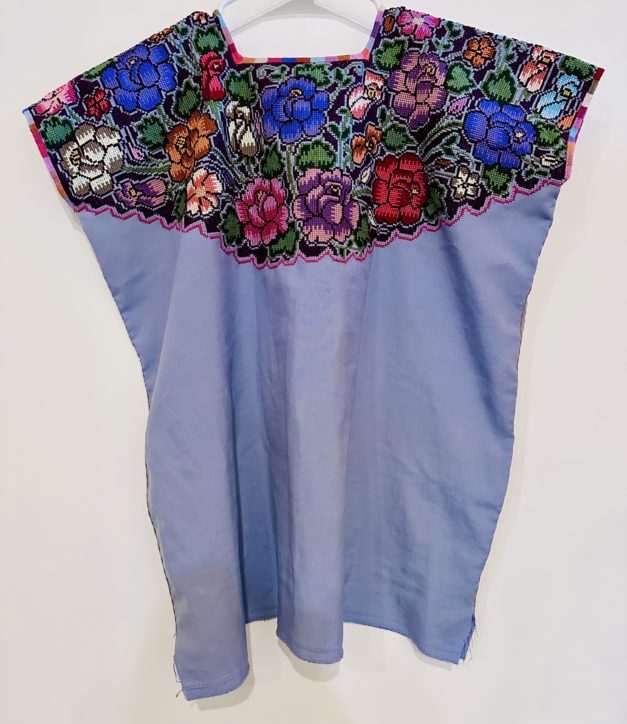Shop Oaxaca Culture — https://shop.oaxacaculture.com — is our new online marketplace for all things Mexico! We hope you check it out. Of course, we offer clothing including amazing blusas (blouses) and huipiles (dresses), rebozos (shawls) and bufandas (scarves), made by our weaver friends in Oaxaca, Chiapas, Guerrero, Puebla, Michoacan, and remote villages tucked into mountain folds throughout the country.
We are also featuring hand-woven, naturally dyed rugs by Eric Chavez Santiago — these beautiful, sustainable, and ethically made floor and wall coverings make a perfect accent piece for any decor. Eric and his wife Elsa Sanchez Diaz are my partners in our Oaxaca Cultural Navigator tours and workshops. They also operate Taller Teñido a Mano, a natural dye studio where they use locally sourced plant materials, including indigo and cochineal to dye wool and cotton, and teach workshops.
Speaking of decor, we have a Home Goods section that offers hand-woven baskets from the Mixteca, hand-carved mezcal cups from the Oaxaca coast, and felted floor mats and rugs. You can find ixtle hand-woven market bags here, too. We will be adding more to this section soon.
In our quest for the remarkable and well-crafted, we have included a Jewelry + More section. This includes a mash-up of materials, from gold to silver, to clay beads, semi-precious stones, and vintage pieces we collect along the journey. See the earrings and necklaces we have posted to date.
As always, we will be adding new items as we source them, so please bookmark the URL and come back to visit us often. We will no longer be using the Oaxaca Cultural Navigator blog for sales.
I’ll be returning to Oaxaca soon, arriving on October 23, just before Dia de los Muertos (Day of the Dead), and I’ll be keeping my eyes open for new and vintage pieces I know you will love. If there is anything in particular you are looking for, too, please let us know and we will try to find it for you.
BTW, we still have a few openings in our Day of the Dead day tours to Teotitlan del Valle and Mitla.
Now you know why you haven’t heard much from me in the last few weeks. Eric and I been working frantically behind the scenes to get this website up and running. We are also working on developing a textile tour to Guatemala for winter 2025, as well as a Women’s Creative Writing Workshop Retreat for January 2025, all as we get ready for upcoming programs, including Original in Mexico City, November 15-20.
True confession is that it’s hard for me to write about Oaxaca when I’m not there, so I hope you forgive me. And, personally, my other endeavors include landscaping, which I call taming the wilderness around my Taos home, and writing creative non-fiction that I read monthly at the open mic at SOMOS, the Taos literary society. At the end of this month, my sister and I embark on a two-week road trip to visit Zuni, Hopi, and Navajo pueblos, as well as Monument Valley, Mesa Verde, Canyon de Chelly, and Chaco Canyon. My connection to and appreciation for native peoples runs deep, whether in Mexico or New Mexico. Let me know if you’d like me to blog about this travel experience.
Sending you all my best, with deepest thanks and gratitude for your interest and support over the many years I have been writing and organizing cultural experiences.
-Norma
Like this:
Like Loading...





























SALE. Shop Small. Shop Artisan Made.
shop.oaxacaculture.com is where you can find the perfect artisan made gift for family, friends, co-workers, and anyone who loves hand-made from Mexico. Perhaps you will find the perfect blouse or huipil for holiday dressing, a hostess gift for someone who has (almost) everything, or something to add pizzaz to your own home decor.
Shop today through December 1 and get a 10% discount off everything you purchase!
Use Coupon Code thankful2023 at check-out.
We rarely discount.
Why Shop Oaxaca Culture?
Your support gives us the means to continue to support women, men, and their families. By doing so, we help sustain traditional, ancestral artisan arts and handcrafts that are at risk of being lost as indigenous cultures become more Westernized.
Shop today through December 1 and get a 10% discount off everything you purchase!
Use Coupon Code thankful2023 at check-out.
We rarely discount.
What we offer for sale:
Please help us spread the word and SHARE THIS POST and shop URL.
Come back often. We post new items regularly. Here are some examples of what you will find on shop.oaxacaculture.com
Like this:
Comments Off on SALE. Shop Small. Shop Artisan Made.
Posted in Cultural Commentary, Shop
Tagged artisan made, baskets, Black Friday, clothing, jewelry, Mexico, Oaxaca, rugs, sale, shop, Shop Oaxaca Culture, Small Business Saturday, sustainable, textiles